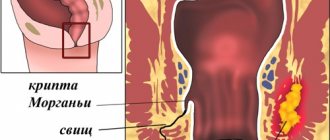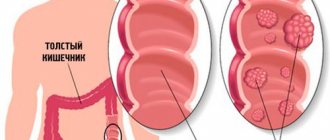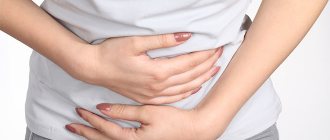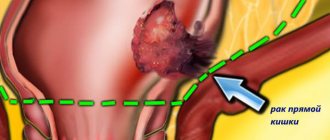The human intestine is a long, hollow organ that acts as a kind of “conductor” of nutrients from food into the blood. If it stops working “as it should”, not only pain of a certain localization and nature appears - all structures of the body begin to suffer, and the degree of their suffering will be different.
The main cause of diseases of the intestinal tube, whether they are tumorous or inflammatory, infectious or resulting from the activation of one’s own flora, is food. In some cases it only helps to “identify” the problem, in others it causes it. The main symptoms of intestinal pathologies are nonspecific: they indicate the localization of the pathological process, but the cause is often required additionally, through additional laboratory and instrumental tests.
How the intestines work
Food processing begins in the mouth, where the salivary glands are located. The saliva they produce contains some enzymes that begin to break down carbohydrates - substances that the body considers most necessary, since they provide energy to the internal organs the fastest.
The entry of food into the mouth “presses” receptors that go directly to the glands located in the stomach and pancreas. These organs are tuned to help with digestion in the intestinal tract.
From the mouth, food enters the esophagus, and then into the stomach. There, partial disinfection of food occurs with hydrochloric acid from gastric juice. The same stomach secretion partially breaks down the proteins present in food. After this initial processing, food enters the intestinal tract: first into the duodenum, then through two more sections of the small intestine, and only then into the large intestine.
The excretory duct of the pancreas opens into the duodenum, which produces enzymes that break down proteins, fats and carbohydrates into “elementary structures”: amino acids, fatty acids and monosaccharides, respectively. The main bile duct also exits here, the bile flowing from it helps to break down fats well. Further, gradually, as it moves through the small intestine, “elementary structures” are absorbed by its mucous membrane and enter the blood and lymph.
This liquid food porridge reaches the border with the colon. There is a kind of valve that allows passage only in one direction. He does this gradually so that the appendix, which is a kind of tonsil, has time to “filter” the contents of the intestinal canal from microbes. Fiber and connective tissue processed by local bacteria are absorbed in the colon. The latter “add” vitamins to the absorbed substances, which are necessary for blood clotting and transmitting impulses from nerves to other nerves, and from them to muscles. It is in this section that bacteria process the remaining proteins in such a way that the products of such processing become the formation of toxic substances (normally they should be excreted in feces), and feces acquire that characteristic smell that is felt when going to the toilet.
The final section of the large intestine is created to form feces by absorbing water from food gruel, in which there is no longer anything nutritious left.
Vomit
A very unpleasant phenomenon that is an involuntary release through the throat and mouth of everything that was in the stomach. As a rule, it is accompanied by rapid breathing, sharp abdominal pain, and increased salivation. True, after the release of vomit, the patient feels relief. Vomiting is usually a sign of many diseases and poisonings. It happens that it is not possible to stop it without the intervention of medical workers.
Therefore, it is important to understand that prolonged vomiting is a very serious symptom, so self-medication in this case is strictly prohibited. Especially if what comes out has impurities of mucus, blood or bile.
By the way, vomiting can occur even with strong excitement or a surge of emotions. For many pregnant women in the early stages, this is generally normal.
Symptoms of intestinal diseases
Since different parts of the intestinal tube are responsible for different processes:
- small intestine - for the absorption of nutrients necessary for the existence of the body into the blood,
- large intestine - for the absorption of water from the “former food gruel” back into the blood, for the formation of formed feces and their timely excretion, for the production of vitamins and ensuring the processing of fiber,
then the symptoms of diseases of the large and small intestines will differ. Most often it happens that the process, which can be:
- hereditary: for example, congenital deficiency of one or another digestive enzyme;
- infectious: both in the form of poisoning, the symptoms of which are caused by the entry of microbial toxins into the gastrointestinal tract, and in the form of inflammation of the intestinal wall caused by the microbes themselves, as well as the simplest amoebae and balantidia;
- parasitic (caused by worms);
- tumor;
- neurogenic or endocrine, when intestinal symptoms are caused by dysregulation of its activity carried out by hormones and the nervous system;
- adhesive;
- chronic inflammatory: for example, Crohn's disease, Whipple's disease, ulcerative colitis,
develops simultaneously in both the large and small intestine.
How do small intestinal diseases manifest?
Diseases of the small intestine manifest themselves:
- Pain that is usually localized in the navel area.
- Liquid stool, which most often has a light color, foamy or mushy character with “inclusions” of undigested foods, especially of plant origin, and a sour, unpleasant odor.
- Feelings and sounds of “transfusion” in the abdomen.
- A feeling of bloating, heaviness, distension of the abdomen, which is slightly relieved by the act of defecation.
- The urge to defecate is imperative and cannot be tolerated.
- Inflammatory bowel diseases can be accompanied by an increase in temperature to different numbers, which depends on the number of microbes ingested, the degree of their toxicity to the body, and the resistance (immunity) of the body itself.
- With the long-term existence of such symptoms, there are signs of suffering in other organs: fatigue;
- weakness;
- weight loss;
- the skin becomes dry and thin;
- nails become thinner, brittle, and become covered with transverse striations;
- visual acuity decreases;
- jams appear in the corners of the mouth;
- the whites of the eyes turn red;
- frequent headaches;
- Dots often “float” in front of your eyes;
- Joints of different locations periodically ache and swell, in which arthritis is diagnosed.
How do colon diseases manifest?
These diseases are characterized by:
- Pain syndrome. Pain in the large intestine is usually localized along the perimeter of the abdomen: on the left side, on the right side. They can be localized above the navel or “in the pit of the stomach,” but less frequently. They are strong, dull, bursting, and make you want to go to the toilet to relieve the condition. The pain comes in waves; not related to food intake. Usually such pain increases in the evening.
- The feces are frequent, foul-smelling, and may contain: blood, mucus, pus, “stripes” resembling swamp mud.
- If the colon becomes inflamed due to infection, the body temperature rises to different levels, appetite decreases, headache and dizziness appear.
- Incontinence of gas and stool.
- Rumbling in the stomach, which, together with a feeling of bloating, increases in the evening, weakening towards the night.
Fungal, autoimmune and infectious diseases
Among intestinal pathologies there are diseases of a fungal nature. Thus, with nutritional errors, immunodeficiency and unreasonable use of antibiotics, intestinal candidiasis develops. The disease is characterized by diarrhea and gastrointestinal discomfort. Some patients, not knowing how to identify this disease, are treated either independently or do not contact a therapist at all.
Intestinal candidiasis can cause numerous complications. The most dangerous of them are intestinal perforation, penetration of ulcers, internal bleeding and the development of fungal infection. When living in environmentally unfavorable areas, the presence of chronic stress, bad habits and irregular nutrition, symptoms and diseases of the small intestine should alert every person.
Some types of intestinal mycoses can be hidden or asymptomatic. Such diseases can be identified using ultrasound, MRI, and colonoscopy.
Among the autoimmune diseases of the gastrointestinal tract, Crohn's disease of the intestine attracts attention. Its etiology is unclear. In developed countries, there is an annual increase in incidence. The classic sign of this rare pathology is pain, diarrhea and bleeding. The pain syndrome may resemble the clinical picture of acute appendicitis, so the doctor often cannot make a reliable diagnosis.
Treatment of this disease is quite complex and does not always give a tangible result, so it is limited mainly to symptomatic treatment.
Infectious intestinal diseases most often occur in the summer. They are caused by eating unwashed vegetables and fruits, and drinking unboiled water. A common culprit of intestinal infections is intestinal amoeba. In a mild form, the disease is characterized by the presence of signs of dysenteric colitis. Stools are very frequent (up to 20 times a day), which causes dehydration. Signs of acute poisoning often increase.
Causes of intestinal tract diseases
Diseases of any part of the intestinal tube can occur due to one of the following reasons:
- Defects or “unsuccessful combination” of genes responsible for the structure and function of the gastrointestinal tract.
- “Overactive” immunity, which, when a microorganism (amoeba, bacteria, virus, fungus) enters the intestinal tract, not only destroys it, but also damages the intestinal wall.
- Incorrect, almost monotonous diet: excessive infatuation with carbohydrates, fats or proteins, carbonated drinks or foods rich in fiber.
- Taking certain medications. “Leaders” in the field of intestinal diseases are antibiotics, which do not damage the organ wall, but change the composition of the microflora, as a result of which not only the absorption of beneficial substrates from food and the production of necessary vitamins changes, but also affects the overall human immunity.
- Sedentary lifestyle. Peristalsis, that is, contractions of the gastrointestinal tract necessary for the movement and “kneading” of food with its uniform processing by enzymes and digestive juices, also depends on human motor activity.
- Bad habits, such as smoking and drinking alcohol, leading to ischemia (that is, a lack of oxygen in the intestinal wall).
- Eating foods contaminated with microbes. The “leaders” in this area are expired dairy products, confectionery products with cream, as well as “healthy” raw eggs, uncooked meat and raw water.
- Eating food with dirty hands or from the same container as a person with an intestinal infection.
- For some viruses that cause intestinal infections, there is also an airborne route of transmission of the microbe from sick to healthy.
- Stress. This factor, influencing the regulation of the digestive system, can cause symptoms of damage to any part of it.
- Some poisons, such as those found in mushrooms, pesticide-treated plants, or liquids not intended for human consumption.
- Increased production of VIP hormone. This leads to impaired absorption of water from the intestines, resulting in frequent watery stools.
- Disruption of brain-gut interaction, which occurs through the spinal cord and fibers of the sympathetic and parasympathetic nervous system.
- Imbalance between hormones and hormone-like substances: histamine, bradykinin, serotonin, cholecystokinin-pancreozymin, which take part in the regulation of the digestive tract.
Intestinal dyspepsia
Signs of intestinal disease associated with disruption of digestive processes in its cavity appear as a result of a violation of secretory function both in the intestine itself and in nearby organs. A lack of digestive segments or stagnation of stomach contents can be caused by improper peristalsis.
A similar manifestation may appear as a result of:
- Intestinal infections, they, as well as the fight against them, lead to changes or destruction of normal microflora;
- Poor nutrition with excess amounts of carbohydrates or fats;
- Psychological or emotional impact, the depressed nervous system weakens the ability of the glands to secrete;
- Chronic diseases.
The main signs are bloating, sensations of transfusion in the lower part of the gastrointestinal tract, unstable stools with frequent diarrhea and a rotten or sour odor, excessive gas production. The best way to eliminate these manifestations is considered to be the so-called “diet No. 4”.
How the small intestine of the digestive system can be affected
The most common inflammation of this section is called “enteritis”. Also, this section can be “pinched” by adhesions, cancer can develop in it or its interaction with the nervous system can be disrupted. The main symptoms of these pathologies are associated with one of two conditions:
- malabsorption - impaired absorption from the intestine;
- maldigestion - a “disruption” of the ability to break down food into its main components. This process can be disrupted either in the intestinal cavity, or in the area of its villi, which absorb food, or already inside the intestinal cells.
Each of these conditions has its own cause:
- Digestive insufficiency in the intestinal cavity is associated with diseases of the glands that help break down food into its components: the pancreas, liver and gall bladder. The condition is aggravated by an unbalanced diet, when, against the background of a large amount of carbohydrates and fats taken, few vitamins are supplied to the food, psycho-emotional stress, as well as previous intestinal infections, when the composition of the microflora of the small intestine has changed significantly.
- Disturbance in the interaction of food with the intestinal villi, which must absorb it, occurs as a result of damage to these villi by various disease processes. This type of maldigestion develops with enteropathies, chronic enteritis, and Whipple's disease. We will talk about them further.
- Disturbance in the supply of nutrients inside the intestinal villi itself, where the blood vessel is located where food should flow. This happens with congenital or acquired deficiency of enzymes that break down carbohydrate disaccharides.
- Impaired absorption of food in the small intestine is associated with changes in the structure of the mucous membrane due to inflammatory and tumor processes, as well as treatment of the latter with radiation therapy. The cause is also a violation of the motor function of the intestine and dysbacteriosis. Malabsorption is also caused by diseases of the liver, pancreas, inflammation of the peritoneum, and systemic diseases that cause damage to all connective tissue present in the body. Impaired absorption of essential substances will also develop after removal of more than 1.5 meters of the small intestine.
Why this “smart” division of dysfunctions of the thin section of the digestive tube? The fact is that they are treated differently, and understanding where the “block” occurred will help to overcome it, and not take general measures.
Features of the digestive system
The human body is a complex mechanism that consists of a large number of systems that function carefully and precisely among themselves, ensuring the full viability of the body. The digestive system plays a key role in maintaining normal functioning. Fats, proteins, carbohydrates and vitamins are broken down by enzymatic action into structural elements that act as “fuel”, accumulating the body with energy and necessary building material. These structural substances are actively used to restore cells and tissues.
The gastrointestinal tract is only part of the digestive system, which performs the following functions:
- motor-mechanical. The main purpose is to provide conditions for transporting food masses throughout all parts of the intestine with their further removal;
- secretory. With its help, chemical processing of crushed food particles is carried out. The process is carried out using enzymes, juices and bile;
- suction Allows you to efficiently establish the process of assimilation of all necessary nutritional components and fluids.
A large number of negative factors can provoke disturbances in the functioning of the digestive system. As a result, disturbances in the functioning of the digestive system and pathologies in the body are formed. This process is facilitated by a number of reasons:
- unbalanced diet: excessive overeating, systematic hunger, lack of a clear meal schedule and eating the same type of foods. Poor quality diet, various additives, preservatives and dyes have a negative impact on the condition of the intestines;
- poor environmental situation. The digestive system is quite sensitive to the low quality of water that humans consume, and animal products today contain a decent amount of pesticides;
- genetic predisposition of a person to various kinds of diseases;
- side effects of medications on the body;
- gross violation of sanitary standards in the process of preparing food;
- satisfactory state of the central nervous system due to stress and overexertion;
- difficult and harmful working conditions;
- manifestation of infectious diseases;
- development of parasitic infestation diseases;
- the course of diseases of the endocrine system;
- the presence of bad habits such as smoking, alcoholism, etc.
You need to treat your health with care and attention, and as soon as the first signs of disturbances in the body’s functioning appear, you should immediately consult a doctor, because a timely decision helps reduce the risks of various types of diseases.
A thorough and detailed diagnosis of the body will clearly identify the causes of the disease. Thus, the doctor will prescribe an effective treatment regimen, which will not only eliminate the disorder, but also neutralize various complications, including. intestinal diseases.
The most common diseases of the small intestine
There are quite a lot of diseases in this part of the digestive tract. With each of them, one or more of the mechanisms described above will be disrupted: absorption or digestion in or outside the intestinal cells.
Eosinophilic enteritis
This is a disease that occurs due to the accumulation in the intestinal wall of blood cells released from the vessels that are responsible for allergies - eosinophils. The reason for it is not clear.
It manifests itself with the following symptoms:
- pain in the umbilical region of the abdomen;
- nausea, vomiting;
- diarrhea, with fecal stools that are difficult to wash off the walls of the toilet;
- food allergies;
- weight loss;
- Ascites may develop - fluid effusion into the abdominal cavity.
In this case, the examination does not reveal signs of tumor, parasitic or other diseases. Typically, relatives of such a person have food or drug allergies.
Whipple's disease
This is an infectious pathology that occurs in people with impaired cellular immunity, whose macrophage cells are unable to “digest” bacteria or bacterial antigens.
This is a rare disease that affects mainly men 40-50 years old.
The first symptoms of the disease: fever, pain in all joints without external changes, abdominal pain of uncertain localization. Then, gradually, the person loses weight, he often has diarrhea, which is accompanied by the passage of fatty, difficult-to-wash feces.
The further course of the disease “brings” extraintestinal symptoms:
- hearing and vision impairment;
- headache;
- inability to look away in any direction;
- hand trembling;
- insomnia;
- heart rhythm disturbance;
- difficulty breathing;
- desire to drink and eat a lot;
- Dementia (dementia) gradually progresses.
Small bowel cancer
It is extremely rare, occurring in 2% of all gastrointestinal cancers. Statistics say that this cancer develops 2 times more often in men. It mainly affects older people, over 60 years of age. The causes of cancer are considered:
- polyps that develop in the mucous membrane when it is frequently inflamed;
- chemical carcinogens contained in canned, genetically modified and fried foods;
- some genetic forms of intestinal polyposis;
- Crohn's disease (more on that below);
- celiac disease;
- diverticulitis;
- nonspecific ulcerative colitis (we will also talk about it briefly);
- irradiation of the abdominal cavity;
- oncological pathologies of other localizations, in which cancer cells enter the small intestine through the bloodstream;
- some genetic abnormalities (for example, Yegers syndrome).
Symptoms of cancer are associated with the fact that the tumor usually grows into the lumen of the intestine, narrowing it and preventing food from passing through this place. Sometimes the first signs are associated with the fact that the tumor “solders together” several organs (intestinal loops, bladder, colon, internal genital organs, neighboring lymph nodes or vessels), growing into them. The visible “beginning” of the disease may be tumor metastasis.
Small intestine cancer manifests itself with the following nonspecific signs:
- periodic nausea, vomiting;
- bloating;
- compressive pain in the navel area that goes away after taking No-shpa, Baralgin or similar drugs.
Subsequently, weight loss, dry skin, and blurred vision appear and increase.
If obstruction develops associated with a critical decrease in the lumen of the intestinal tube, this is manifested by severe bloating, vomiting, cessation of gas discharge, abdominal pain and dehydration. This condition requires urgent surgical intervention.
Crohn's disease
If the specific inflammation that develops with this pathology affects the wall of the small intestine, the following symptoms occur:
- pain in the navel area;
- rumbling in the stomach;
- diarrhea.
Gradually, a person experiencing such attacks loses weight, his skin becomes thinner and dry, jams appear in the corners of his mouth, nails crumble and turn yellow, and red spots appear on the skin.
Symptoms and signs of bowel disease
There are many reasons why intestinal diseases can occur; symptoms and signs of the disease help to detect the pathogen and determine the pathology. Some of them are of a very general nature; they only indicate the very fact of the presence of the disease; pain in the lower abdomen, for example, will not allow one to find out the nature of the disease.
The fact of the disease can also be determined by the violation of the basic functions of the part of the digestive tract in question - food is not digested, diarrhea occurs, feces are excreted with mucus.
Impaired motor function, the most common consequence of this manifestation is constipation. It is also a symptom of intestinal disease and can occur if the muscles in the intestinal wall do not move stool.
With prolonged fasting, there is no content left in the intestines, which is why peristalsis may be reduced or stop completely. Food entering the intestines hits special receptors, which stimulates peristalsis. In case of illness, it accelerates or slows down.
Normally, there are 1-2 bowel movements per day, and the stool is formed; if intestinal function is impaired, the stool becomes loose and frequent, or constipation occurs.
Functional bowel diseases:
- Irritable bowel syndrome;
- Constipation - inability to move stool;
- Diarrhea—liquefaction of fecal matter;
- Flatulence - release of gases;
- Abdominal pain is constant pain in the abdominal area.
Excessive peristalsis can be observed due to nervous shock, excitement and fear can accelerate peristalsis, resulting in diarrhea, a painful condition expressed by colic in the abdomen and loose stools, it can also complement the symptoms of intestinal disease, it can be triggered by poor nutrition.
Foods with a rough structure (of plant origin) with a lot of indigestible residues, fatty foods or foods that are unusual for the body can cause loose stools.
Diarrhea sometimes manifests itself as a protective-adaptive reaction, the body thus gets rid of products harmful to it. Many laxatives are based on rhubarb and castor oil; the body often tries to “throw off” such substances.
Chronic bowel diseases:
- Irritable bowel syndrome;
- Nonspecific ulcerative or non-infectious colitis;
- Diverticular disease;
- Chronic ischemic colitis.
In most cases, diarrhea is a consequence of inflammation of the intestinal mucosa; in parallel, the absorption of water and nutrients for the body slows down, so the food entering this part of the digestive tract does not harden. This can also happen when blood stagnates in the veins.
Infected areas produce exudate, which further dilutes the food in the intestines. Infection and inflammatory processes can be caused by microorganisms that were either part of the microflora or entered the body from external sources.
The intestinal microflora consists mainly of fermentative bacteria, which consume carbohydrates and provoke the fermentation process, and putrefactive microorganisms, which ensure the decomposition of proteins, causing putrefaction.
Normally, both processes are present in the body, but they are more pronounced in the case of illness. During enteritis, fermentation processes in the small intestine intensify significantly, and fermentation masses appear during bowel movements.
With colitis, putrid diarrhea appears. Having correctly assessed the key signs of intestinal disease, an experienced doctor will be able to determine, even by the nature of the diarrhea, which of its parts is affected.
Infectious bowel diseases can occur due to:
- Viruses – enterovirus, rotavirus;
- Bacteria – causative agents of typhoid fever, cholera, salmonellosis;
- Toxins produced by harmful microorganisms, this type of disease is called botulism.
Reproducing in the body, microorganisms get out and infect other people through vomit and fecal matter; less often, pathogens are excreted in the urine. Most microorganisms that can infect the lower part of the digestive tract are extremely tenacious and resistant; they can survive in water, in soil, and on household objects.
In frosty temperatures they go into cysts, so pathogens can easily survive in harsh winter conditions. In water, minced meat, and milk, microorganisms multiply especially quickly.
They enter the body through the mouth when a person takes contaminated water and food; dysentery, for example, can be contracted by drinking unboiled milk, and salmonellosis can be contracted through chicken meat and low-quality meat products.
Common pathologies of the large intestine
The most common diseases affecting the large intestine are:
Colon dyskinesia
It is also called “irritable colon”, “mucosal colitis”. The pathology manifests itself as periodic attacks of bloating, rumbling in the abdomen, and pain in the abdomen, usually relieved by defecation. Attacks occur after an error in diet or stress. When examining, no changes in the digestive canal are detected, since the basis of the disease is a violation of the nervous regulation of its work.
Diverticulosis
Diverticula are sac-like protrusions of the intestinal wall in the direction opposite to its lumen. They occur in people who prefer food poor in plant fibers and fiber. Most often, diverticula begin to appear only in old age or senility. Their “favorite” localization is the left sections of the intestine.
The disease does not manifest itself in anything special for a long time. Occasionally, abdominal pain and constipation may occur. The appearance of symptoms is associated with complications of diverticulosis: diverticulitis (inflammation of the protrusion), the occurrence of ulcers and suppurations in the diverticula. This is manifested by persistent abdominal pain, vomiting, weakness, fever, pain when touching the abdomen. This clinical picture suggests that surgical intervention is required.
Chronic colitis
This disease can occur after suffering from dysentery; it can be caused by worms and protozoa such as Giardia. Chronic colitis can develop as a result of chronic poisoning with salts of heavy metals, and also become a “response” to taking allergenic foods.
Symptoms are nonspecific and occur in attacks:
- stomach ache;
- bloating;
- the urge to defecate, after which the bowel movement itself does not occur;
- diarrhea, which is replaced by constipation;
- nausea;
- mucus and streaks of blood are found in the stool;
- weight loss;
- decreased appetite;
- irritability;
- insomnia;
- headache.
Nonspecific ulcerative colitis
This is a disease whose cause has not yet been determined. The most common theory considers bacteria to be the main “culprit” for the appearance of ulcers on the mucous membrane of the colon. It is confirmed in treatment: taking specific antibiotics can significantly improve a person’s condition.
UC appears:
- bleeding of scarlet blood from the rectum;
- periodic diarrhea;
- severe pain in the left half (maybe in the right) of the abdomen;
- decreased performance;
- weakness.
Ulcerative colitis can become a precancerous disease, as well as a cause of intestinal contents entering the abdominal cavity, so it must be “kept under control” with medication, checking the condition of the ulcers by endoscopic methods (sigmoidoscopy, colonoscopy) every 6-12 months.
Crohn's disease
With this pathology, there is the appearance of areas of inflammation in any part of the gastrointestinal tract, from the esophagus to the sigmoid colon. In this case, all the membranes of the “digestive tube” are affected.
The first symptoms of this intestinal disease:
- pain in the abdomen, usually in the right side, reminiscent of an attack of appendicitis;
- bloating;
- diarrhea;
- increased body temperature;
- rumbling in the stomach.
If the swelling of the intestinal wall is so significant that it blocks the lumen of the digestive canal, partial or complete intestinal obstruction develops, which is manifested by bloating, cessation of gas discharge, and vomiting. At first there may be stool, then it stops and becomes impossible.
When Crohn's disease persists for a long time, a person's joints often hurt and become swollen, pain begins on the right side under the rib, and red spots appear on the skin similar to an allergic rash.
Colon cancer
This disease develops quite often. Risk factors for its development are considered to be a diet rich in animal fats, flour foods and foods without fiber, alcohol intake, stress and trauma to the mucous membranes from foreign objects. The “culprit” is also the long-term existence without treatment of intestinal polyposis, ulcerative colitis, when the cells of the lining of the intestinal gastrointestinal tract, modified as a result of chronic inflammation, have to transform even more, becoming little similar to those that should be in this localization.
Signs of colon cancer are:
- constipation, especially if the tumor grows inside the intestinal canal;
- stomach ache;
- the appearance of blood in the stool, although there does not have to be a lot of it; single blood streaks are sufficient for examination;
- increase in temperature, usually to small numbers;
- weight loss;
- periodic diarrhea;
- weakness.
In the early stages, the disease is “silent”; it can only be detected if you undergo annual preventive endoscopic examinations.
Other diseases
The large intestine can become a localization for the development of such surgical diseases as:
- papillitis;
- paraproctitis;
- cryptite;
- anal fissures;
- haemorrhoids;
- rectal polyposis;
- rectal condylomatosis;
- epithelial coccygeal duct and its cyst.
How to examine the intestines for diseases
Every doctor who wants to find out the cause of an illness associated with a disorder of the digestive tract should know how to examine the intestines for diseases. The simplest examination methods are inspection and palpation. Before examining the organ itself, you need to palpate the abdomen or perform percussion, special attention should be paid to its shape.
A retracted stomach is a consequence of fasting, intestinal spasms, and meningitis. A bloated abdomen is a sign of dropsy, flatulence, and tumors. If the internal organs have dropped, the upper part of the abdomen sinks in and the lower part protrudes outward.
When lying down, the fluid collected in the abdominal cavity spreads to the sides, and the stomach seems to be flattened. Tumors are characterized by protrusion of parts of the abdomen.
Diagnosis of intestinal diseases also includes palpation; the research method is direct palpation of the abdomen with the hands in a relaxed position of the patient. You need to pay attention to pain and the presence of tumors. If superficial palpation does not produce results, the study is carried out more deeply.
To determine the causes of bacterial infection, a laboratory analysis of stool is performed, which can determine the composition of the microflora, the presence of helminths and other pathogens.
Diseases that affect both intestinal sections
This includes adhesive disease, which is treated in a surgical hospital, and infectious gastroenterocolitis, which is treated by infectious disease specialists.
Adhesive disease
Adhesive disease is a pathology that is characterized by the appearance of “jumpers” between the abdominal organs. They consist of the same tissue that makes up the outer wall of the digestive canal and the peritoneum, and can lead to compression of the internal organs from the outside and a change in their localization.
Symptoms of intestinal adhesive disease are nonspecific and depend on the location of the moorings (also called adhesions): swelling and severe edema can also appear when they, like adhesions, block the lumen of the “tube” through which food moves. They are as follows:
- abdominal pain, which initially has a clear localization, then becomes diffuse;
- constipation;
- feeling of bloating;
- stopping the passage of gases;
- nausea;
- vomiting, and the vomit may have a fecal odor.
Until the passage of food through the digestive canal is disrupted, adhesive disease will practically not make itself felt. This can only occur:
- unstable stool, when constipation gives way to diarrhea,
- also abdominal pain, which is initially local in nature (localization can be indicated with a finger) and appears several hours after eating food.
Infectious gastroenterocolitis
This diagnosis is made when there are signs of an intestinal infection, but there is still no bacteriological analysis of stool, by which it would be possible to say which microbe caused the disease: is it dysentery, salmonellosis, coli infection or another.
The disease usually appears 3-24 hours after eating an expired, sour, unrefrigerated product, or a product prepared in violation of technical specifications. Most often, such foods are dairy and fermented milk products, raw eggs, products with pastry cream, salads with mayonnaise and undercooked meat. The cause may also be water drunk from an open reservoir and unboiled.
Symptoms of infectious gastroenterocolitis are:
- temperature increase;
- weakness;
- nausea and vomiting;
- cramping abdominal pain that decreases after bowel movements;
- the stool may be fecal in nature (especially at first), then “just water” may be released;
- there may be streaks of blood, mucus, “swamp mud” in the stool, the stool itself may resemble “jelly”;
- with profuse vomiting or diarrhea, dehydration quickly sets in, characterized by hoarseness, severe weakness, even fainting, decreased blood pressure, darkening of urine and a decrease in its quantity (up to complete cessation of urination);
- if the microbe that caused the process is very aggressive, then weakness, decreased blood pressure and clouding of consciousness can occur even without dehydration.
About gastrointestinal diseases
Modern medicine classifies diseases of this vital department into a large section - gastroenterology. This includes not only diseases of the intestines, but also of the esophagus, stomach, pancreas, liver, gall bladder, and intestines.
The most characteristic symptoms of intestinal diseases are similar and are indications for immediate consultation with a doctor. You need to know what the symptoms of stomach and intestinal diseases are in order to respond to them in time.
Among them, the following conditions should be highlighted:
- Stomach ache;
- Heartburn. Some patients may feel pressure and distension in the abdomen.
- Pain behind the sternum;
- Belching;
- Fever;
- Swallowing disorders;
- Nausea and vomiting;
- Constipation of various types;
- Diarrhea.
These are the most common symptoms of stomach and intestinal disease, which may vary in each specific situation.
The most dangerous localization of pain is in the right abdomen
Pain on the right side of the abdomen can accompany diseases not only of the intestines, but also of other organs. Let's try to find the cause of the pain depending on its nature:
Nagging pain
Their reasons may be:
- in women – inflammation of the uterine appendages (adnexitis, salpingoophoritis);
- right ovarian cyst;
- in men: prostatitis;
- in men and women: cystitis.
Aching pain
If they develop in pregnant women in the first two trimesters of pregnancy, they may indicate a threat of miscarriage. After 30 weeks, they “talk” about an imminent birth.
In non-pregnant women and men, this type of pain may indicate the onset of infectious enterocolitis or a functional bowel disorder caused, for example, by foods rich in fiber or fat.
Sharp pain
This type of pain indicates the need to contact a surgeon, because it may be:
- appendicitis;
- ovarian rupture;
- intestinal tumors;
- torsion of the pedicle of the right ovarian cyst;
- in men, it can also be a sign of sexually transmitted diseases, cystitis or urethritis.
Stitching pain
This character most often indicates diverticulitis or intestinal tumors.
Severe pain
They are characteristic of Crohn's disease, appendicitis, and sometimes of ulcerative colitis.
Acute pain
It is typical for an ectopic pregnancy during a rupture of the right fallopian tube in which the fetus ends up. The same word can be used to describe ovarian apoplexy and acute appendicitis.
Blunt pain
Among the many reasons, the main ones are:
- adnexitis;
- pyelonephritis;
- cysts of the uterine appendages;
- cystitis.
Cramping pain
This is how it is usually described:
- ectopic pregnancy;
- renal colic, associated, for example, with the passage of a stone through the ureter;
- appendicitis;
- biliary colic;
- in pregnant women - labor has begun.
Acute conditions
Acute abdomen is a surgical condition that requires immediate intervention. Strong tension in the abdominal muscles usually indicates that critical changes have occurred in the body:
- obstruction;
- appendicitis;
- volvulus of intestinal loop;
- ulcer;
- Possible ectopic pregnancy.
This is just a small list of serious acute diseases that require surgical treatment and urgent hospitalization.
If you have an acute abdomen, you should never treat yourself. The sooner hospitalization occurs in a specialized medical institution, the greater the chances of not just recovering, but also surviving.
Intestinal diseases in children
In childhood, several pathologies of the intestinal tract are most common. This:
- intestinal infection caused by rotavirus, salmonella, shigella dysentery and many other microbes;
- congenital deficiency of enzymes, most often those that break down the components of mother's milk;
- malformations of the intestinal tract, for example, Hirschsprung's disease, congenital megacolon, stenosis (obstruction) of the lumen of the intestinal tube;
- intussusception, that is, the “insertion” of one section of the intestine into another, which most often develops at the age of 1.5 months or later, requires urgent surgical intervention.
Slightly less common are diverticulitis, spastic, ulcerative and pseudomembranous colitis, polyposis of the intestinal tract, and local tumors.
Symptoms of intestinal diseases in children will depend on the cause of the disease:
- With an intestinal infection, this will include fever, vomiting, diarrhea, sometimes streaked with blood, and refusal to eat.
- Surgical pathology: intussusception, appendicitis, intestinal stenosis have rapidly increasing symptoms: the baby’s tummy swells, vomit appears, which most often has a greenish color or contains uncurdled milk or undigested food. The child initially cries, is restless, presses his legs to his stomach, but quickly becomes lethargic, indifferent, and refuses to eat or drink.
- Enzyme deficiency is manifested by profuse diarrhea in the presence of certain (usually dairy) foods; when the formula is replaced with a lactose-free one, this symptom disappears and the child begins to gain weight.
In children under 6 years of age, any complaint of abdominal pain, bloating or vomiting should prompt an immediate examination by a surgeon with an ultrasound scan of the abdominal cavity. Due to the peculiarities of the innervation of the intestinal tract at this age, the child will not be able to indicate the exact location of the pain, and even appendicitis will not have a characteristic location of pain - in the lower and right abdomen.
Parents should remember that the younger the child, the less fluid loss he needs for critical dehydration, so “stool 10 times, with a volume of 2 tablespoons” in an infant is a reason to contact a pediatrician, infectious disease specialist or pediatric surgeon on the same day.
Where to go if you have intestinal pain
If you are often bothered by any of the above signs indicating intestinal disease, then you need to make an appointment with a gastroenterologist. If there are clear signs of an infectious disease, then an infectious disease specialist will be able to provide assistance and prescribe competent treatment. Rectal disease is treated by a proctologist .
If the cause of discomfort is the formation of a tumor, then an examination by an oncologist is necessary. Another article on this topic: What causes white stool?
In addition to the above specialists, it is important to consult with a nutritionist, since the health of the gastrointestinal tract depends on proper nutrition. Diagnostic measures to identify the cause of intestinal disease are carried out by an endoscopist.
Treatment of intestinal diseases
In order to begin treatment, you need to find the cause of the disease. For this purpose, studies such as:
- Ultrasound of the abdominal cavity, for which you need to prepare;
- X-ray of the abdominal organs. Conducted without contrast, it only allows one to see intestinal obstruction that has arisen against the background of an adhesive, inflammatory or tumor process, but not to find out the cause. If there are no signs of obstruction, then an x-ray with contrast can be performed. This will make it possible to see a tumor, diverticula or area of inflammation.
- CT scan. A precise research method that allows you to visualize many different pathologies.
- Endoscopic examinations, which make it possible to examine the digestive tube from the inside by inserting a device into its cavity. This may be a FEGDS, when the examination is carried out up to and including the duodenum, or a colonoscopy, when an endoscope will help examine the colon. To examine the small intestine, special capsules are used that a person swallows, and they display an image of the section where they are currently located on the monitor.
- Bacteriological examination of stool: used if infectious gastroenterocolitis is suspected.
- It is possible to clarify the nature of the process, the malignancy or benignity of the tumor only with the help of histological examination. To do this, during an endoscopic examination (if there are no signs of malignancy) or separately during laparoscopy, you need to “pinch off” a piece of the formation or inflamed intestine to make a diagnosis. If a malignant process cannot be excluded, the material taken during the operation is sent for histological examination, because the risk of further potential spread of cancer cells is greater than a “pity”. The surgeon first makes sure that there are no metastases in the liver, bones, or kidneys, and acts accordingly during such an operation, removing only a section of the intestine. If metastases are visualized before the intervention, the volume of the operation is increased and chemotherapy and radiation therapy are started.
Symptoms of diseases of the large intestine
The thick section is the lower part of the intestine, which is responsible for the absorption of nutrients from food by the human body. It consists of 4 sections: the cecum, colon, sigmoid colon, and rectum. Violations of the functionality of the thick section include:
- Ulcerative colitis. A person with ulcerative colitis experiences symptoms of an appendicitis attack. Characteristic signs include pain on the left side, blood in the stool and chronic diarrhea. Treatment is aimed at antibacterial, enzyme, enveloping and analgesic therapy. Treatment of ulcerative colitis requires following a special diet that excludes many foods, such as fried, salty or overly sweet foods. The patient is often prescribed physical therapy, cleansing enemas, and herbal teas for brewing.
- Appendicitis. Appendicitis is characterized by fever, nausea, and dizziness. Drug treatment is not appropriate here, so surgery is performed to remove this part of the intestine. Afterwards, the patient undergoes a course of treatment and is discharged from the hospital.
Diagram of an inflamed appendix
Are common
A group of intestinal diseases is called general pathologies because they are characterized by a specific disease of the walls or part of the intestine.
Crohn's syndrome
Inflammation spreads to all layers of the intestine. In addition, the affected intestine is only part of the diseased organs. In the chronic course of the disease, the pathological process covers both the esophagus and the stomach.
In the intestine there are places with a narrowed lumen. The mucous surface and the intestinal lymphatic system are affected.
Leads to consequences:
- elevated temperature,
- fistula formation,
- skin rashes,
- deterioration of liver function,
- decreased vision,
- joint damage.
Ischemic pathology
The pathology is associated with vascular disease in the intestinal walls. As a result, their narrowing may occur, organ tissues do not receive additional nutrition, and oxygen starvation may occur.
Symptoms:
- pain in the abdomen,
- blood spots in the stool,
- general malaise,
- nausea,
- accelerated peristalsis.
The consequences of pathology may appear:
- thrombus in a vessel of the intestinal wall,
- insufficient nutrition or its complete absence in certain areas contributes to tissue death,
- intestinal dysfunction.
Adhesive process
Adhesions occur as a result of:
- long-term inflammatory process in the intestinal walls,
- complications after surgery,
- ischemia of organ tissue.
Symptoms of pathology that will complement the general symptoms characteristic of intestinal disease:
- deterioration of stool movement and intestinal release,
- signs of intestinal dysfunction due to necrosis of its individual sections.
Intestinal sphincter problems
The sphincter is responsible for regulating the process of excretion of feces. There are a wide variety of reasons that can initiate a disruption in its work.
Signs of the disease:
- severe pain during defecation,
- the presence of blood in the stool,
- false urges,
- pain can radiate to neighboring organs. Timely treatment has a good prognosis.
Types of intestinal diseases | Alternative medicine devices
The end of summer is the time when intestinal diseases peak. Therefore, in this review I would like to give a small list of the most common pathological conditions of the intestine.
Intestinal diseases are different in nature. They can occur as a result of infection or the action of parasites; they can be caused by food poisoning or disruption of digestive processes. These conditions can be individual symptoms of other diseases of the digestive tract and independent nosological forms.
The most common are: colitis, chronic enterocolitis, constipation, flatulence, diarrhea, dysentery, duodenitis and helminthiasis.
Colitis is an inflammatory process of the mucous membrane of the large intestine. Colitis can be acute or chronic. The causes of colitis are infections and intestinal neurosis. Colitis is treated with medications or hormonal agents, sometimes it is necessary to resort to surgery. Prevention of some types of colitis consists of proper nutrition.
Chronic enterocolitis is a chronic inflammation of the intestines that leads to depletion of the body. Treatment of chronic enterocolitis is at a sanatorium-resort, and if necessary, the patient is placed in a hospital. Just as with non-chronic colitis, the basis of prevention is proper nutrition.
Dysentery is an infectious disease caused by single-celled parasites; it arises and develops as a result of non-compliance with sanitary standards. During an outbreak of dysentery, you need to protect yourself from contact with sick people, drink only boiled water, and it is not recommended to eat food if you are not sure of its quality, for example, at catering points. Therefore, in this case, it is better to eat home-cooked food. Raw foods must be washed thoroughly with warm running water.
Duodenitis is an inflammatory disease of the duodenum, which can be either acute or chronic. Duodenitis, as a rule, occurs against the background of acute inflammation of the intestines and stomach; for its treatment, therapeutic fasting, gastric lavage, bed rest, and a special diet are used. In some cases, surgery and antibiotic treatment are used. Prevention of duodenitis consists of proper nutrition and not abusing alcoholic beverages.
Helminthiasis is a disease caused by parasites (worms); they can enter the human body by eating unwashed vegetables and fruits, by eating raw or half-raw meat and fish, or from dirty hands when eating. Accordingly, the prevention of helminthiasis is based on compliance with basic rules of personal hygiene.
Constipation, diarrhea and flatulence are most often not independent diseases, but only symptoms of more complex diseases or disorders of the gastrointestinal tract. Therefore, if these phenomena last more than one or two days, and even more so if other unpleasant sensations are present, it is necessary to consult a doctor in order to identify the main cause of these disorders.
www.altmedpribor.ru
Intestinal (stomach) flu
This disease sounds like gastroenteritis in medical language, since in fact it is not the flu. The cause of this disease is a number of viruses, such as rotaviruses, caliviruses and others.
Children or elderly people are susceptible to this disease. Adults can also suffer from this disease, but since most often they have a fairly strong immune system, the disease occurs without symptoms.
The disease is transmitted through the consumption of unwashed fruits or vegetables, through airborne droplets, and through contact with other previously infected people.
Once in the intestines, the disease agents disrupt the digestive processes, or, more precisely, they lead to a failure in the processing of carbohydrates. They begin to accumulate in the small intestine, this leads to the accumulation of large amounts of water, which ultimately leads to acute diarrhea.
Signs of intestinal flu:
- redness of the throat, pain;
- runny nose, sneezing, cough;
- diarrhea, stool 5-10 times a day, profuse, strong odor;
- strong rumbling in the stomach;
- vomiting, nausea;
- progressive weakness;
- vomit;
- possible dehydration.
Treatment
Treatment for intestinal flu consists of reducing the level of intoxication and preventing dehydration. The first step is to carry out rehydration therapy. When the patient’s condition has stabilized, you can begin to eat, while strictly following a gentle diet. It is also necessary to take medications aimed at suppressing the virus, as well as reducing the factors associated with the disease.
Data
Stomach flu and influenza are completely different diseases. Of course, they have some common symptoms, such as a runny nose and sore throat, but these are completely different diseases that should be treated differently.
Stomach flu is a highly contagious disease. In order to minimize the risk of contracting it, it is necessary to strictly observe personal hygiene. The cause of infection can be not only contact with a dirty surface, but also contact with dirty water.
The greatest danger this disease poses is dehydration. If it occurs, the person may die.
When treating intestinal flu, there are no specific medications; only the accompanying signs of the disease can be treated; the rest requires support from the body, which can independently overcome the disease.
Bowel treatment methods
Cleansing and fasting days
The correct functioning of the digestive system in the modern rhythm of life is almost impossible. If you monitor your diet, situations of regime violations still arise. The easiest way to improve your intestines is to cleanse them. Periodically you need to arrange fruit and vegetable days for yourself, and the effect is achieved by following such a diet for several days. Fiber and pectin substances help cleanse clogged intestines.
Herbs and plants
If the problem requires more serious treatment, then pharmacies sell special herbal preparations to normalize intestinal function.
The following plants have a cleansing effect: alfalfa grass, senna leaves, buckthorn bark, knotweed, horsetail, nettle. Regular consumption of leafy green tea and chamomile flower decoction, which has an anti-inflammatory effect, has a beneficial effect on the condition of the intestines.
Proper nutrition
There are many useful recipes for treating the intestines that have actually proven their effect.
Cabbage and potato juice, beets, semolina porridge, pumpkin and watermelon pulp normalize intestinal function. Watermelon has a good pain-relieving effect.
You can cure sluggish bowel syndrome (low motility) with honey and aloe. Heat 2 parts of honey to 40°C and add 1 part of crushed and peeled aloe leaves, mix and leave for 1 day. Take 1 tbsp in the morning, an hour before meals. l., washed down with a glass of warm water. The course of treatment is 14 days. Store the mixture in the refrigerator.
Massage and exercise
Abdominal massage reduces pain, normalizes peristalsis and eliminates colic. It is enough to run your hand over the stomach 10 times, clockwise. The method is designed to quickly improve the condition.
Exercises that restore the activity of a lazy intestine:
- Lying down: leg movement imitating a bicycle; swinging the lower part of the abs by raising bent or straight legs; abduction/extension of the knees.
- Standing: retracting and relaxing the abdomen; walking in place with high knees; rotation of the torso to the left side.
Causes
Below is a list of negative factors that cause various intestinal diseases. As a rule, these factors are not detected individually; in people suffering from intestinal problems, several of them are almost always detected.
The number of factors in one specific case determines how difficult the patient’s treatment will be. Factors that have a serious impact on the development of intestinal diseases:
- malnutrition;
- congenital predisposition;
- acute and chronic stress;
- immunity;
- hyperpassive lifestyle;
- bad habits, especially smoking;
- viral and bacterial infections;
- negative reaction to long-term use of certain drugs.
How to diagnose?
It is important to obtain a complete understanding of the disease, its location, and the nature of the lesion.
To do this, research is carried out:
- Capsule endoscopy makes it possible, among other things, to detect Crohn's disease;
- Colonoscopy allows you to look at all parts of the intestine;
- magnetic resonance imaging - detailed and high-quality diagnosis of the organ;
- upper endoscopy allows you to examine the small intestine;
- X-rays can determine pathological parameters.
Specialists also prescribe tests for diagnosis:
- blood,
- feces
Ischemic disease
If the intestinal circulatory system works with insufficient power, then a person develops ischemic intestinal disease. This disease can occur in both mild and acute forms; it can affect both the entire intestine and its individual part.
The disorders that this disease leads to depend on which intestinal arteries are affected by coronary artery disease. For example, the most acute form of the disease develops when the mesenteric arteries are damaged. It is quite common in people suffering from cardiovascular failure.
In this case, the disease manifests itself as severe painful attacks in the abdominal area, which are practically impossible to anesthetize; even narcotic drugs do not always help. They begin to subside as the infarction of the entire intestine progresses.
A sign that there is an active blockage in the intestinal arteries is vomiting blood, which has a distinct vomitous smell. Also, there is an increase in the number of visits to the toilet, the stool becomes liquid with blood.
At the same time, the patient is in full swing developing intestinal necrosis and peritonitis. The latter leads to a person experiencing severe pain with any mobility. Also, blockage of small vessels leads to the appearance of ulcers and bleeding.
Treatment
The main treatment for this disease is emergency surgery. It consists in promptly eliminating the cause of blockage of blood vessels, and also in eliminating tissue that has undergone necrosis. Any other treatment can only be used to aid recovery in the postoperative period. If the operation is not performed on time, the patient will suffer extensive intestinal bleeding and die.










